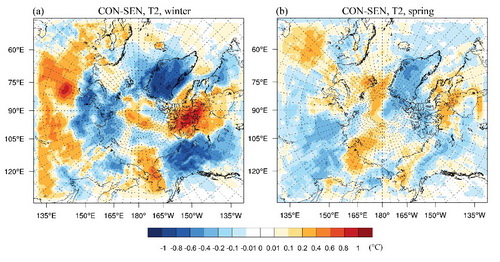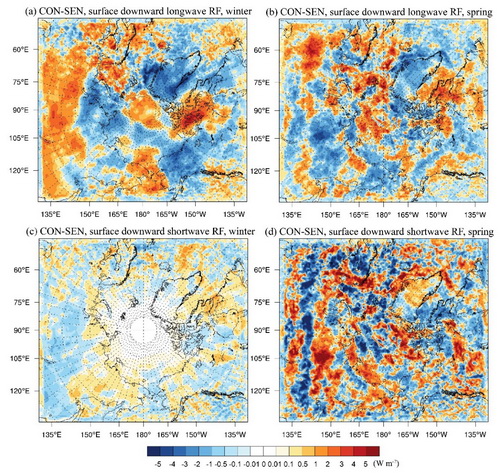Scientists Investigate the Black Carbon Climate Effects in the Arctic in Winter and Spring
Updatetime:2020-09-30From:
【Enlarge】【Reduce】
As an important light-absorbing aerosol, black carbon (BC) can affect the energy balance of the earth-atmosphere system via direct and indirect radiative forcing. When BC deposits on snow and ice, it can trigger BC-snow/ice feedbacks, giving further effects on climate. The Arctic region is especially sensitive to climate change, and previous studies found that increases in BC emissions may contribute to the amplification of Arctic warming.
Recently, a research team led by Prof. KANG Shichang from the Northwest Institute of Eco-Environment and Resources (NIEER) of the Chinese Academy of Sciences (CAS), in cooperation with researchers from Sun Yat-sen University, explored the responses of meteorology and atmospheric stability to BC–cloud–radiation interactions in the Arctic preliminarily based a regional climate-chemistry model (WRF-Chem).
WRF-Chem reproduced the temporal variations of meteorological variables and BC concentration well. Results showed that BC concentrations in the Arctic in winter were mostly higher than those in spring, and the BC-induced near-surface temperature changes were also stronger.
The study shows that effects of BC on near-surface water vapor mixing ratio were consistent with the spatial pattern of near-surface temperature changes, which was probably correlated with the local circulation anomaly due to the temperature changes. Additionally, the changes in near-surface temperature and horizontal wind can also affect the atmospheric stability.
Depending on analysis of the surface radiation changes, this study revealed that the downward longwave radiation related to cloudiness changes played an important role for driving near-surface temperature in the Arctic in winter. While in spring, the relatively less changes in near-surface temperature may be the result of the mutual compensation between the surface longwave and shortwave radiation effects.
The above findings about the climate effects of BC in the Arctic in winter and spring (So-called Arctic haze period) will lay a foundation for comprehensive assessments of the effects of BC on Arctic warming. This study has been published as an article entitled “Investigation of black carbon climate effects in the Arctic in winter and spring” in the journal Science of the Total Environment.

Fig.1. Average changes in 2-m temperature in winter and spring. (Image by Prof. KANG's group)

Fig.2. Average changes in surface downward longwave and shortwave radiative forcing
in winter and spring (Image by Prof. KANG's group)
Contact:
Xintong Chen
E-mail: chenxintong16@mails.ucas.ac.cn
State Key Laboratory of Cryospheric Science, Northwest Institute of Eco-Environment and Resources, Chinese Academy of Sciences, Lanzhou 730000, China.
Appendix




